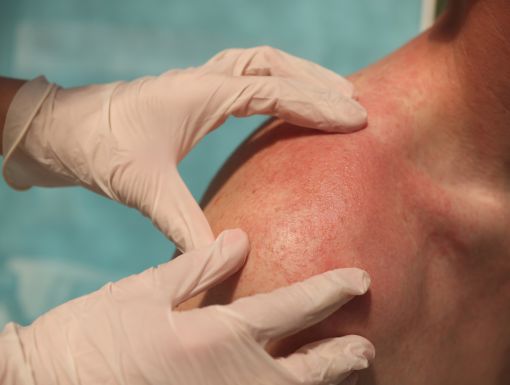
When Should You Get Tested For Prostate Cancer?
Prostate cancer is the most common cancer and the second leading cause of cancer death among men, with approximately 300,000 new cases detected and 35,000 deaths per year in the United States alone.
When prostate cancer is found before it spreads, the chances for a cure are significantly higher.
Ochsner MD Anderson Cancer Center recommends men speak with their primary care doctor or urologist at age 45 about the benefits and risks of prostate screening to check for prostate cancer.
Prostate cancer screening usually consists of a blood test that measures baseline prostate-specific antigen (PSA) levels.
What is a PSA blood test?
The prostate-specific antigen or PSA is a blood test used to determine men at risk for prostate cancer screening. It is the leading method of screening for prostate cancer. The screening can help catch the disease early when treatment may be more effective and have fewer side effects.
It measures the level of prostate-specific antigen, a protein made by cells in the prostate gland (both normal cells and cancer cells). Prostate-specific antigen is mainly found in semen, but a small amount is also found in the blood. Blood levels can be elevated in people with prostate cancer.
During a prostate-specific antigen test, a small amount of blood is drawn from the arm and measured. The chance of having prostate cancer increases as the prostate-specific antigen level increases, but there is no set cutoff point that can tell if a man does or doesn’t have prostate cancer.
How will my doctor decide if further testing is needed?
Many doctors use a prostate-specific antigen cutoff point of four ng/mL or higher when deciding if further testing is needed, while others might recommend it starting at a lower level.
However, we advocate for more intelligent and responsible interpretations of the test. We know that the prostate-specific antigen test will vary according to age, prostate size and ethnicity. With appropriate screening, we know we can decrease prostate cancer death by up to 20%.
Some things to know include:
- Most men without prostate cancer have prostate-specific antigen levels under four ng/mL of blood. When prostate cancer develops, the prostate-specific antigen level often goes above four. Still, a level below four does not guarantee that a man doesn’t have cancer. About 15% of men with a prostate-specific antigen below four will have prostate cancer if a biopsy is done
- Men with a prostate-specific antigen level between four and 10 (often called the “borderline range”) have about a 1 in 4 chance of having prostate cancer.
- If the prostate-specific antigen is more than 10, the chance of having prostate cancer is over 50%.
How is prostate cancer treated?
Prostate-specific antigen screening is sometimes criticized because it can lead to aggressive treatment of all prostate cancer patients.
Yet, decades of research and observation have shown us that not all prostate cancers are created equally.
Some prostate cancers are minor and, with proper surveillance, may never affect a patient’s health. In contrast, other prostate cancers are more aggressive and are better off being treated.
The difficulty in the past has been determining which prostate cancers are the “bad” ones and deserve more aggressive treatment.
In general, low-risk prostate cancers are watched more under active surveillance, which means the cancer is not treated but monitored to ensure it doesn’t progress. Active surveillance frequently measures prostate-specific antigen levels and periodic prostate biopsies.
If low-risk prostate cancers progress, or if a patient has a more aggressive form of the disease at the time of diagnosis, we can still achieve excellent outcomes with minimally invasive treatments.
Options for prostate cancers confined to the prostate gland include surgery or radiation therapy. Sometimes radiation is given following surgery. After surgery or radiation, hormone therapy is often given to decrease the risk of prostate cancer recurrence.
Male sex hormones, specifically testosterone, are a driving factor for the development and progression of prostate cancer. Hormone therapy decreases the effect of testosterone on the cancer by reducing the production of testosterone or blocking the binding of testosterone to receptors on the cancer.
Is prostate cancer curable?
Prostate cancer is one of the most treatable types of cancer, especially when detected early. In fact, many men diagnosed with prostate cancer go on to live long, healthy lives.
Curability largely depends on the stage of the disease at diagnosis:
- Localized prostate cancer, which is confined to the prostate gland, has an excellent prognosis. In these cases, treatment options such as surgery (radical prostatectomy) or radiation therapy often result in a complete cure.
- Locally advanced prostate cancer, which has spread just beyond the prostate, can still be treated effectively with a combination of therapies, including radiation and hormone therapy.
- Metastatic prostate cancer, which has spread to distant parts of the body, is typically not considered curable. However, advances in treatment have made it possible to manage the disease for many years. Hormone therapy, chemotherapy, immunotherapy, and targeted treatments can help control the cancer and improve quality of life.
Other factors that influence outcomes include:
- The Gleason score, which measures how aggressive the cancer cells are
- PSA (prostate-specific antigen) levels in the blood
- The patient’s age and overall health
Early detection is key. That’s why routine screenings and regular checkups are so important.
Learn more about Brandon Cottrell, MD, and schedule an appointment.



